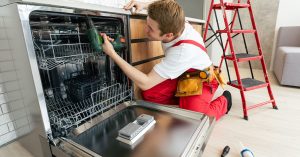Appliances make life easier until one suddenly stops working. A broken fridge, washer, or oven can interrupt daily routines and add stress. That is when professional help matters. At JAY Appliances, we understand how important it is to know what to expect when calling for help. A clear picture of the process can make the experience smoother, faster, and more comfortable.
Understanding the Initial Call
Every service visit begins with the first phone call or online booking. During that step, technicians gather essential information about the appliance type, the issue, and any error codes or noises noticed. This helps them prepare the right tools and possible parts before arriving. The more accurate the description, the quicker they can find the problem.
We often remind customers that even small details help. Noting when the problem started or whether it happens consistently can guide the technician. Having the model number ready also speeds things up. That number is usually found on a small label inside the door, back panel, or near the base of the appliance.
Scheduling and Arrival
After the initial contact, scheduling comes next. Professional services aim to arrive within a specific time window and always provide notice before heading out. A reliable team treats punctuality as part of respect for the customer’s time. Technicians typically confirm their arrival and may update customers if traffic or other delays occur.
Once at the home, technicians introduce themselves, wear appropriate footwear protection, and inspect the area around the appliance. Having a clear workspace helps them start immediately. Pets or small items nearby should be moved to keep the area safe. This preparation ensures that the visit stays efficient and accident-free.
The Diagnostic Process
The heart of any visit is the diagnostic stage. Professionals use experience and specialized tools to identify the root cause, not just the symptoms. It can include electrical checks, water pressure testing, or temperature readings depending on the appliance. The goal is accuracy before any repair begins.
A key part of diagnosis is transparency. Technicians explain what they find and often show the specific part that failed. That openness builds trust and helps customers understand why certain repairs are needed. At this point, customers usually receive a clear quote outlining labour, parts, and service fees before any work starts.
Repair Authorization and Work
After diagnosis, technicians wait for approval before proceeding. Once given, they begin the repair immediately if parts are available. Many carry common components in their vehicles, which reduces the need for return visits. If a unique part is required, they order it quickly and schedule a follow-up appointment as soon as it arrives.
During repairs, safety remains a priority. Professionals unplug appliances, turn off water valves, or disconnect gas lines where necessary. These steps protect both the home and the technician. Careful handling of wires, seals, and panels ensures the appliance is restored without causing additional damage.
Quality Checks and Testing
After completing the repair, a responsible technician never leaves without confirming that the appliance works correctly. They test functions such as heating, spinning, cooling, or draining, depending on the type of machine. This step prevents repeat issues and confirms that the job is done properly.
Good technicians also monitor for hidden concerns like vibration, leaks, or unusual sounds that might signal another potential failure. A small adjustment made at this stage can prevent another breakdown later. For many customers, this is the most reassuring part of the visit because they can see the appliance return to normal operation before payment.
Clean Up and Respect for the Home
A professional visit is not only about fixing the appliance but also about leaving the space as it was found. That includes removing tools, wiping surfaces, and ensuring no packaging or parts remain behind. The work area should look tidy and safe.
Technicians may also share simple maintenance advice before leaving. That advice might include cleaning filters, avoiding overloads, or checking seals regularly. Such small habits can extend the life of any machine and prevent future breakdowns. Simple care often saves money in the long term.
Payment and Warranties
Once the work is complete, payment details are reviewed. A clear invoice should list all parts, labour, and service fees. Many professional services include short warranties on parts and workmanship, which provide peace of mind in case the same issue returns.
It helps to store the invoice and warranty information safely. That documentation becomes valuable if another problem appears later. Technicians may also remind customers of maintenance intervals or seasonal checks to avoid recurring issues.
After-Service Support
Good service does not end when the technician leaves. Reliable companies offer follow-up support for any related questions or concerns. That support could be a phone call or email to confirm satisfaction and ensure that everything is running smoothly.
Sometimes customers notice a new sound or setting change after a repair. Instead of worrying, they can simply reach out for clarification. Having dependable after-service communication helps maintain confidence in the repair and builds long-term trust between the technician and the homeowner.
Benefits of Choosing Local Professionals
Working with local experts brings several advantages beyond convenience. Local technicians are familiar with common appliance models found in the area and can often respond faster. They understand the city’s climate, which affects appliances like freezers and dryers more than many people realize.
Choosing experienced technicians for appliance repair in Edmonton ensures that the work meets both professional and local standards. It also supports a community-based approach where service providers genuinely care about reputation and customer satisfaction. In most cases, the turnaround time is shorter because travel and scheduling remain flexible.
How to Prepare for a Service Visit
Preparation plays a big role in how smoothly a repair goes. Customers can help by clearing a path to the appliance, unplugging it if safe, and securing pets. Gathering relevant paperwork like the user manual or previous repair records also helps.
If the appliance is leaking, try to turn off water valves and place a towel underneath. For refrigerators, keeping doors closed maintains the temperature until the technician arrives. These small actions protect both the appliance and the home environment while allowing the repair process to move quickly.
Common Mistakes to Avoid
One common mistake is trying to fix an issue without the right tools or knowledge. This can worsen the problem or create safety risks. Another mistake is ignoring early warning signs like noises or error codes. Small problems often turn into costly breakdowns when left unattended.
Homeowners should also avoid delaying a professional visit once an issue appears. Waiting too long can cause parts to wear down or damage connected systems. Quick attention helps maintain the appliance’s lifespan and saves money on larger repairs.
Questions to Ask During a Repair Visit
Asking the right questions helps customers feel informed. Simple questions such as “What caused the problem?” or “How can I prevent this from happening again?” lead to practical answers. It is also smart to ask about warranty coverage and part replacement options.
Technicians appreciate engaged customers because it shows a shared interest in the appliance’s long-term health. Understanding why a repair was necessary helps people spot similar issues in other household machines. These conversations turn a one-time visit into a learning experience.
Long-Term Appliance Care Tips
Preventive maintenance remains the best way to reduce future repair costs. Regularly cleaning filters, checking hoses for cracks, and avoiding overloads can make a big difference. Keeping appliances level prevents vibrations and protects internal components.
Unplugging unused appliances during long trips reduces power surges and saves energy. Wiping down surfaces helps prevent buildup that affects performance. These habits keep machines running efficiently year after year. They also reduce energy use, which lowers monthly utility bills.
When to Replace Instead of Repair
There are times when replacement makes more sense than another repair. Age, repeated breakdowns, or discontinued parts can all influence that decision. Most appliances last between 8 and 15 years depending on type and usage.
A professional technician can help weigh the costs by comparing repair estimates with replacement options. If a repair costs more than half the price of a new unit, replacement may be wiser. Still, an expert opinion ensures that customers make an informed and financially sound choice.
Building Trust with Reliable Service
Trust is built through consistent results. Professional technicians earn that trust by arriving on time, working safely, and communicating clearly. When customers feel respected and informed, they are more confident about future repairs.
For that reason, choosing qualified local professionals is worth the effort. Their knowledge of local conditions, access to parts, and familiarity with common models make every visit more efficient. Open communication and honest pricing complete the experience.
If your household needs dependable help, do not wait for the next breakdown. You can easily contact us to schedule a visit with experienced technicians who understand how to bring your appliances back to life.
FAQs
1. How long does a typical appliance repair visit take?
Most visits last between 45 minutes and two hours depending on the complexity of the issue and the availability of parts.
2. Should I unplug the appliance before the technician arrives?
If it is safe to do so, yes. Unplugging reduces risk and allows quicker inspection once the technician arrives.
3. What information should I provide during the booking?
Give the appliance type, model number, and a short description of the problem. Mention any noises or error messages if noticed.
4. Can I stay home during the repair?
Yes. In fact, it is recommended so you can approve work, ask questions, and review results after the repair.
5. How often should I schedule maintenance checks?
Basic maintenance once a year keeps appliances running efficiently and helps catch issues before they become expensive problems.



